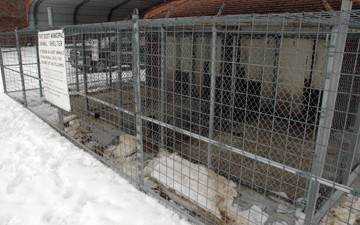Overcrowding, ice buildup force killing of 12 dogs at animal shelter

A local veterinarian euthanized 12 dogs last week due to a combination of overcrowding and ice build-up at the city's animal shelter.
It was the biggest mass killing of dogs, ages 1 to 3 years, in the three years Julene Smith has been Fort Scott's animal control officer.
The animal shelter, located at 601 N. Barbee St., is divided into in four kennels or "runs" that can each hold a maximum of four dogs. Their bedding, food and water are inside the shelter, but the dogs can go through a doggie door outside to a concrete patio area where they can then relieve themselves.
Smith cleans up the feces and washes the concrete with disinfectant each morning to keep the area sanitary. It helps stave off possible diseases or infections the dogs could get from prolonged exposure to the feces.
The problem occurs when Smith rinses the concrete with water. In the last several weeks, temperatures have consistently been below freezing. The way the shelter is built, the water runs down into the largest kennel at the end of the shelter. Water collects in the area and freezes.
The winter storm that dumped about two inches of sleet, two weeks ago, created about three inches of ice in that section of the shelter. There were 16 dogs, which is means the shelter was filled to capacity during that time. Many of the dogs housed where the ice accumulated were defecating on the ice, creating an unsanitary condition because it froze into the ice, leaving Smith unable to adequately clean the pen. The result: no room for the dogs.
"I can't clean up because of the poop being frozen inside the ice," Smith said. "I can't wash down or disinfect, because the ice freezes and I get more of a build up."
Something had to give, and that something consisted of a visit from a veterinarian, who put down 12 of the 16 dogs. After receiving one more, the pound currently has five dogs, most of them puppies.
She's been busy chipping the thick ice in pieces, scooping it up and dumping the ice outside the cages. All the feces-filled ice and snow are gone, and Smith can now use that portion of the shelter.
There's a three-day waiting period for dogs from the time they are picked up until they're euthanized, dependent on whether anyone claims or adopts them. However, they hold dogs for more than three days when space is available, Fort Scott Police Lt. Shaun West said. If a dog has been there for more than three days and the shelter reaches capacity overflow, that dog will be in jeopardy of being euthanized, he said.
Other animal shelters have heated concrete floors that prevent ice accumulation, Smith said.
Adoption can't keep pace with the number of dogs seized, Smith said. There were 33 dogs seized last December and only seven dogs adopted, according to Fort Scott police statistics.
It costs $37 to adopt an animal, but $30 of that is refunded, if the owner gets the dog spayed or neutered.
